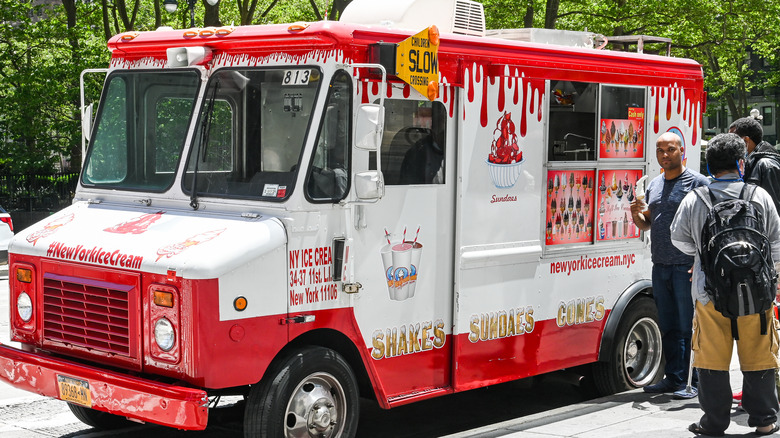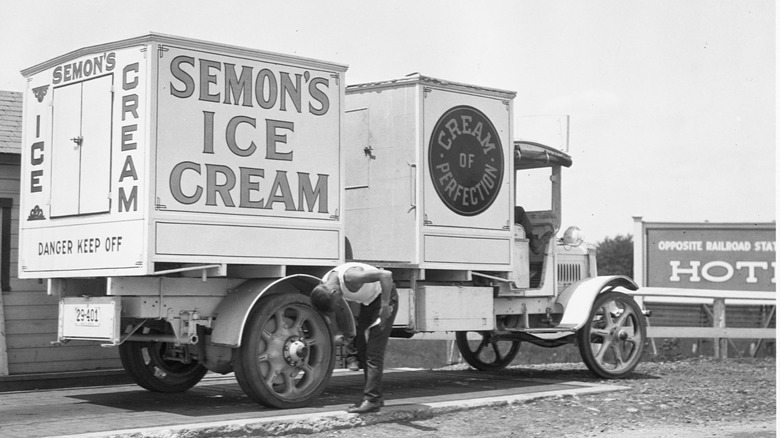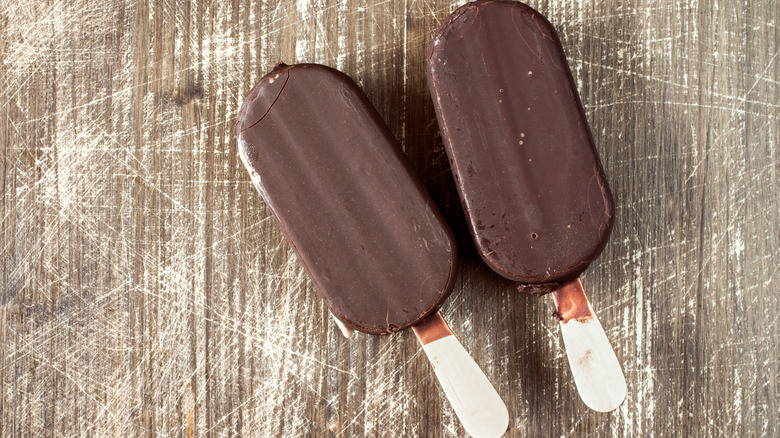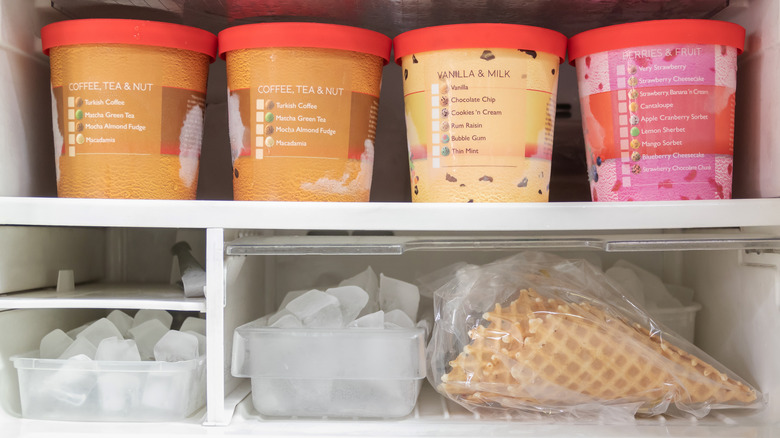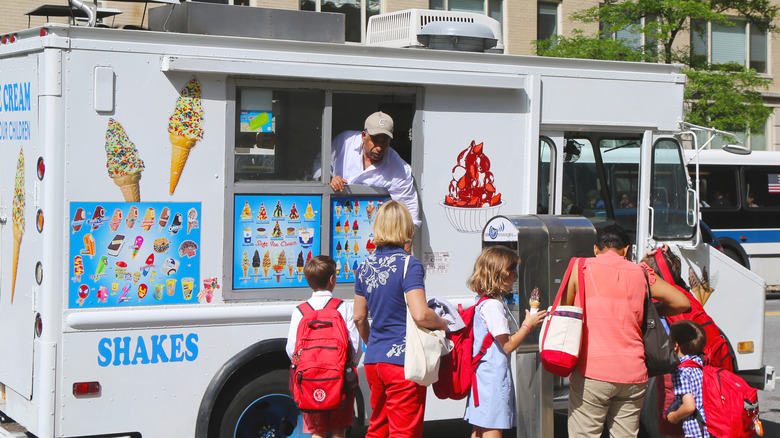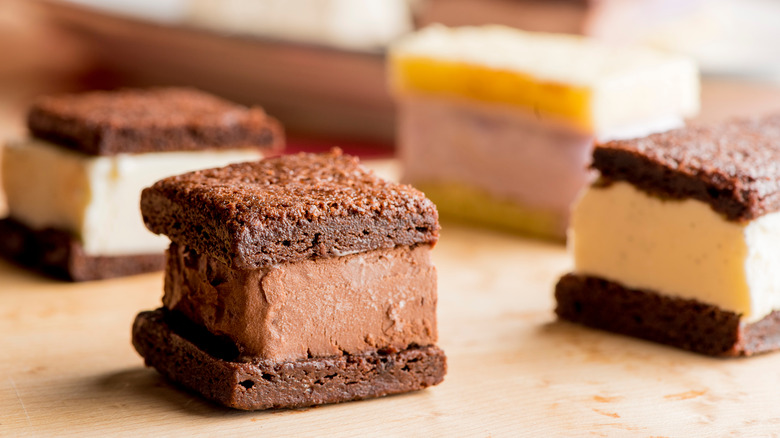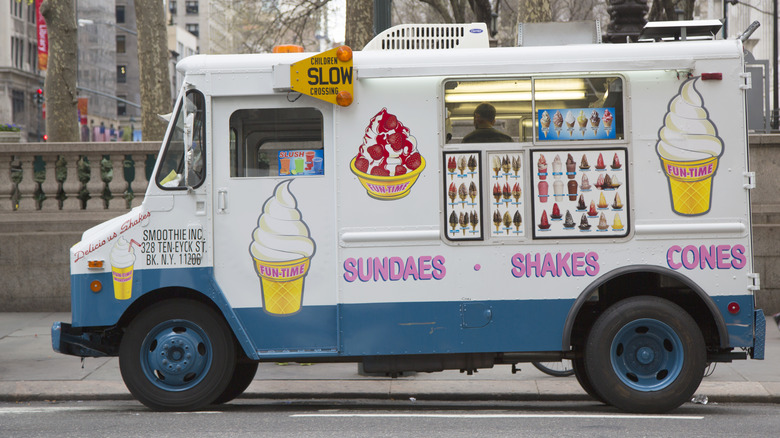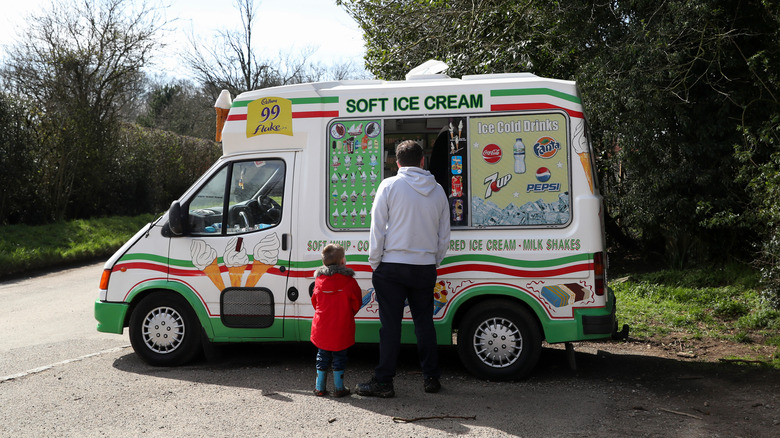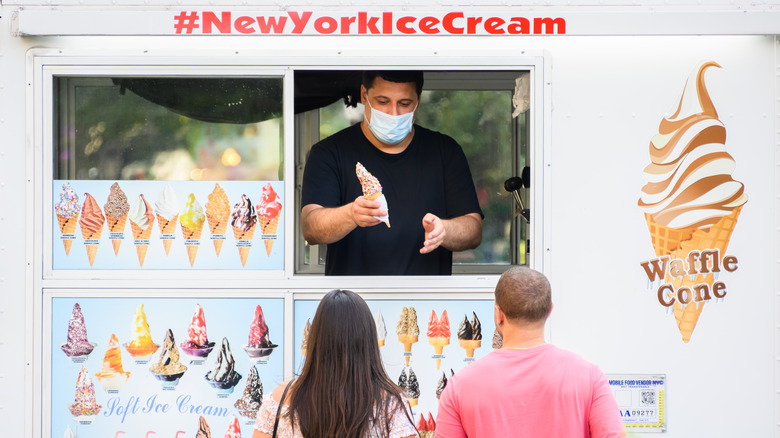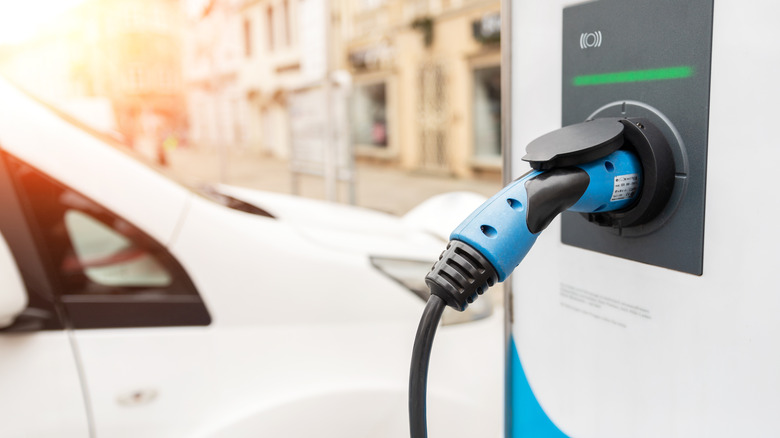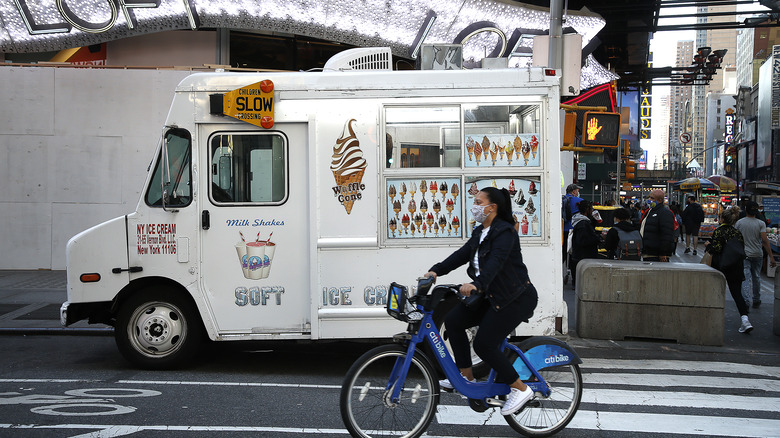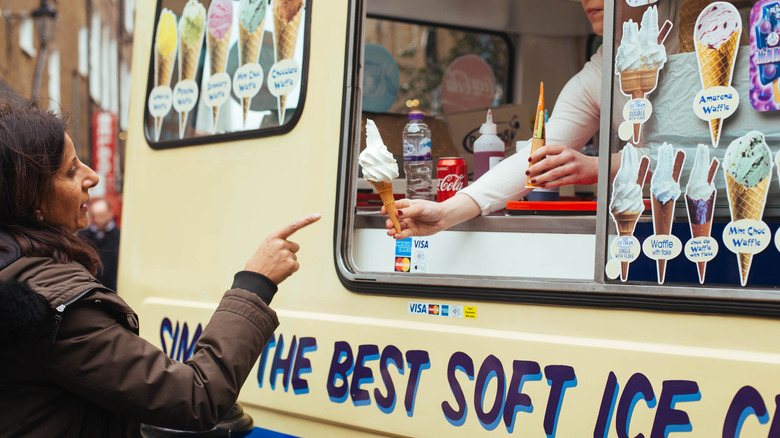The Untold Truth Of Ice Cream Trucks
The ice cream truck jingle elicits memories of hot summer days and cool treats. It's not as common as it once was to come across an ice cream truck making its way through the neighborhood these days, but those that do exist drive on. Ice cream trucks seem inherently nostalgic, but there are many companies working hard to make on-the-go ice cream more than just a distant memory of the long lost days of yore.
The history of ice cream trucks is long and sweet — when vendors first began selling ice cream, they did so out of pushcarts instead of trucks. These ice cream pushcarts first hit the streets around the time of Prohibition; many people were eager to find an alternative to booze, and they found it in these sweet, easily accessible treats. Since then — despite multiple economic crashes — ice cream trucks have continued to make their mark on the sweet-toothed among us, roaming the streets with their familiar jingle. Though prices have increased over the years, that hasn't yet stopped people from flocking to their favorite truck on a warm summer afternoon.
Ice cream trucks rose in popularity during prohibition
In 1920, Congress passed the Volstead Act, putting into motion what would become nearly 15 years of alcohol prohibition in the United States. Most bars and breweries shut down during the Prohibition era, but a few found a new product whose sales sustained them until 1933, when alcohol was widely available again. That product was ice cream. Between 1920 and 1929, when sales of alcohol plummeted, ice cream sales increased 40% (via History).
According to History, in 1923, the first refrigerated ice cream trucks hit the market with the Good Humor treat brand (a company that's still popular today). Author Anne Cooper Funderburg recounted in her book "Chocolate, Strawberry, and Vanilla: A History of American Ice Cream," that men who used to head to the saloon for alcohol made do with a frozen ice cream treat instead. Rather than spending evenings at the bar, people would frequent ice cream trucks–indulgence came in a different form during Prohibition, but thanks to the surge of readily available sweet treats, there was no shortage of it.
Ice cream bars were an early ice cream truck treat
Harry Burt was a candy maker in Youngstown, Ohio who is credited with opening the first ice cream truck in the U.S. According to Mahoning Valley Historical Society, Burt owned a penny candy shop when he was 18-years-old. His store was simple, but his desserts were widely known for their deliciousness.
As Burt's business grew, the confectionery became a full restaurant, including a soda fountain and ice cream options. In the early 1920s, as Burt's company was expanding, he created a chocolate coating that would harden over ice cream. Burt's children helped him realize that, though the chocolate-coated ice cream was messy to hold with one's bare hands, there was a simple solution. Burt's son, Harry, suggested that consumers could hold the ice cream with a wooden stick, and "a new clean convenient way to eat ice cream" was born. These ice cream bars were the perfect treats to sell out of Burt's refrigerated trucks, which he purchased between 1922 and 1926, as his business success and the freezer invention coincided.
The invention of the electric freezer changed the ice cream truck game -- and prevented disease
When Harry Burt created his homemade ice cream pops, the invention of the electric freezer allowed his business to deliver ice cream faster and further. According to Smithsonian, Burt's was the first company to use freezers installed in trucks rather than the pushcarts most ice cream sellers used at the time.
Before Burt's ice cream truck hit the market, the pushcarts that ice cream had been served in previously made people sick. It was, per an article in the 1878 issue of Confectioners' Journal, "apt to be adulterated with ingredients which sacrifice health to cheapness." But when Burt's clean, white, refrigerated ice cream trucks, dubbed Good Humor, hit the streets, consumers forgot all about their prior bouts of food poisoning. Drivers wore crisp white suits, reminiscent of nurse uniforms, implying a sanitary environment for ice cream lovers everywhere.
In the 1930s, ice cream truck drivers made good money
Driving an ice cream truck may not be very lucrative these days, but when the ice cream truck industry was taking off in the 1930s, ice cream truck drivers could make good money selling their frozen desserts. According to Smithsonian, drivers could make the equivalent of about $1,800 working just one day in the streets of cities like New York or Chicago.
The Great Depression was ravaging the economy at around the time when ice cream trucks were becoming more commonplace. Many working-class citizens struggled to find work during this time, but ice cream trucks provided workers with consistent paychecks, despite the state of the economy.
Unfortunately, making a living by driving an ice cream truck in the 21st-century is a little more difficult. According to Zippia, the average yearly salary of an ice cream truck driver is $28,524, while other estimates put it at around $34,500. For comparison, an $1,800 daily pay totals over $450,000 annually. Ice cream truck drivers may have enjoyed their time on top for a while, but they aren't exactly living lives of luxury these days.
Ice cream sandwiches were the first frozen treat to monopolize the market
As ice cream became a popular frozen dessert, ice cream makers began developing different ways to eat it. There were a few other classic desserts, like the hokey-pokey, bite-sized Neapolitan-flavored ice cream squares, and penny licks, which was regular ice cream served in a glass instead of a cone (via Mental Floss).
Ice cream sandwiches became one of the most sought-after items in an ice cream truck, and were even known to bring people together. An article from 1900 states that "brokers themselves get to buying ice cream sandwiches and eating them in a democratic fashion side by side on the sidewalk with the messengers and the office boys." It seems unlikely that an ice cream sandwich is going to solve the current class divide, but we wouldn't argue against a truck parked outside the office (especially if Wall Street is paying).
Mister Softee ice cream trucks are historical relics
In 1955, the Conway brothers, William and James, worked at an ice cream machine manufacturer called Sweden Freezer. It was here their idea for the truck that would become Mister Softee was born. According to Eater, the Conway brothers noticed that the freezers their company was installing in ice cream trucks weren't meant for the open road.
"They were taking the ice cream machines and bolting them to the truck, but for a lot of reasons, that doesn't really work well," William Conway's son, Jim, told Eater. "You need shock absorbers, and you need to be able to keep the machine cool." The Conways realized that specialized freezers made to last in moving vehicles would be necessary to avoid the constant repair work the original version required. So they quit their jobs at Sweden Freezer and set off on their own.
Initially, the Conway brothers planned to sell their ice cream trucks to other companies, but as their business grew, they realized that making a profit depended on marketing their trucks as their own. "They decided if they were going to make any money, they should start a franchise so they could get a stream of revenue from each sale," said Conway (via Eater).
Ice cream trucks once announced themselves with a bell, not a catchy tune
Harry Burt's contribution to the ice cream truck business was even more substantial than his chocolate ice cream coating. According to Mahoning History, Burt outfitted his ice cream truck with a bobsled bell — it wasn't quite the full jingle that ice cream trucks are known for these days, but it got the point across. The bells on Burt's truck chimed as he drove, alerting passersby of the promise of a sweet treat just around the corner. Burt was so pleased with the success of his new marketing technique that he added bells to another 12 Good Humor trucks.
Before long, the bells became music. Paul Hawkins, a businessman from California, came up with a system to play music directly from his truck, replacing the bells with real music. Soon, composers were creating music made specifically for ice cream trucks, and drivers had a whole catalog of songs to choose from. Speakers blaring, the ice cream truck jingle soon became a beckoning call for children and adults with sweet tooths.
A common ice cream truck jingle has a racist history
Ice cream truck jingles have long elicited happy memories of snacking on sweet treats in the summertime, but according to NPR, some of the most popular ice cream truck songs have a dark history. Although not all ice cream trucks have the same jingle, the song that is most commonly played has overtly racist lyrics.
The song, adapted from a traditional British tune called "The (Old) Rose Tree," was given new lyrics by immigrants in the U.S. — lyrics that reflected the country's attitude toward Black people at the time. These lyrics were inspired by minstrel shows in which actors wore blackface and performed demeaning shows to mock Black folks for their own enjoyment (and, as NPR points out, profit).
Fortunately, ice cream truck drivers had the good sense to exclude the lyrics to their favorite jingles, sparing neighborhoods from hearing the N-word blasting from speakers meant to attract young, impressionable children.
A famous rapper created a new ice cream truck song
After news spread of the racist origins of the ice cream truck song, a rapper decided it was time to take the ice cream jingle into his own hands. RZA, a member of the Wu-Tang Clan, stepped in to help when Good Humor, Harry Burt's ice cream truck empire, wanted to change their tune.
"To create a new jingle, we knew we had to team up with the mastermind behind some of the most memorable melodies of our time," Russel Lilly, the Senior Director of US Ice Cream at Unilever, told Highsnobiety. RZA signed onto the project because he had his own fond memories of eating ice cream on hot summer days, and he wanted to create an opportunity for kids to have similar experiences without grappling with a racist theme song.
"I remember the days when I would hear that iconic ice cream truck jingle outside, and I would drop what I was doing to chase it down for a treat," said RZA in Highsnobiety. "When I learned about that song's problematic history this summer, I knew I had to get involved and do something about it."
Ice cream trucks are essential services
When the Covid-19 pandemic struck the globe in early 2020, most businesses were forced to close their doors. Essential services, like grocery stores and hospitals, stayed open, and the workers on the front lines made it possible for people to get their needs met despite a deadly disease ravaging communities across the world. One of those more unexpected essential services was ice cream trucks. According to AARP, most ice cream trucks continued driving throughout the pandemic. Their drivers took as many precautions as possible, but many drivers thought it was important to deliver ice cream in the midst of a dark time.
"We are essential," said Godfrey Robinson, an ice cream truck driver in New York. "We are providing a service, making you and your family happy during the pandemic, without a pandemic, rain, sleet, or snow. I feel that I can bring that joy to people" (via The New York Times).
Ice cream trucks are becoming environmentally friendly
In the United Kingdom, Nissan is trying to ensure that ice cream trucks aren't such aged historical relics that they become environmental hazards. For the U.K.'s annual Clean Air Day in 2019, Nissan revealed their zero-emission ice cream truck, an engine based on an electric Nissan model. Most ice cream trucks use antiquated equipment that has been used for years. Though these electrical systems may work, they release large amounts of carbon dioxide into the air. Many of the trucks use diesel engines to keep the freezers running even when the trucks aren't driving.
"Ice cream is enjoyed the world over, but consumers are increasingly mindful of the environmental impact of how we produce such treats," said the managing director of Nissan. "By eliminating harmful tailpipe emissions, and increasing our use of renewable energy, we can help make this a better world for everyone" (via Tech The Lead).
"Operation Meltdown" revealed ice cream trucks were avoiding paying traffic tickets
In the summer of 2019, at least 50 ice cream trucks in New York City were revealed to be a part of a city-wide scam that culminated in a whopping $4.5 million bill. According to CBS New York, "Operation Meltdown" targeted ice cream truck drivers who had refused to pay their traffic violations — together they received over 22,000 tickets from 2009 to 2017.
New York ice cream trucks were known for parking in places they shouldn't, running red lights, speeding, and performing other basic violations. "That's terrible because if kids are running towards ice cream trucks but they're not stopping, or they're not stopping at red lights or stop signs, they could get run over," said a Long Island City resident.
Instead of paying their tickets when they received them, the drivers created fake companies and filed their trucks' ownership under those companies' names. The plan worked until the Department of Finance found out the companies weren't real — and millions of dollars hadn't been paid.
Ice cream isn't as cheap as it once was
There was once a time when ice cream trucks brought people of different socioeconomic backgrounds together. According to Mental Floss, ice cream sandwiches, delivered in pushcarts, were a popular summer treat for both blue and white-collar workers. Ice cream was cheap enough that anyone could afford it, and it was tasty enough that everyone wanted it. People lined up in the streets for ice cream and ate together on the sidewalk. "They started ice cream as a street food," said Laura B. Weiss, the author of "Ice Cream: A Global History."
Unfortunately, though, that's not the case these days. Hamidu Jalloh, a 25-year ice cream truck veteran, told The Washingtonian that while ice cream preferences over the years have remained mostly the same (ice cream sandwiches, cartoon popsicles), the prices have changed. Whereas a snow cone once sold for just 50 cents, these days they cost about two dollars.
Ice cream trucks don't always play nice when it comes to territory
The feud began in 2013. A new ice cream truck company hit the streets of New York City alongside longtime ice cream giants like Mister Softee. Mister Softee had been the most renowned ice cream truck in the city for 61 years when Dimitrios Konstantakakos bought 12 trucks and named his company Master Softee. The following year, Master Softee was sued for stealing Mister Softee's name — and not long after that, the Mister Softee franchise sued their rivals again for using their jingle, too.
After a brief time-out, Master Softee returned as New York Ice Cream. But the war didn't stop there. As lawsuits progressed, news emerged of New York Ice Cream truck drivers threatening Mister Softee drivers. In a New York Times report, a Mister Softee operator said, "If one of my drivers goes to Midtown, they'll [New York Ice Cream] bring their trucks in and surround them ... They'll start banging on the windows."
A New York Ice Cream driver said each company has its own designated territories. "You will never see a Mister Softee truck in Midtown. If you do, there will be problems, and you won't see him there very long." As of 2017, New York Ice Cream had obtained 30 new trucks. Though they continue to put up a fight against the Mister Softee reign, Mister Softee's extra years of experience give them a strong upper hand (via Eater).
